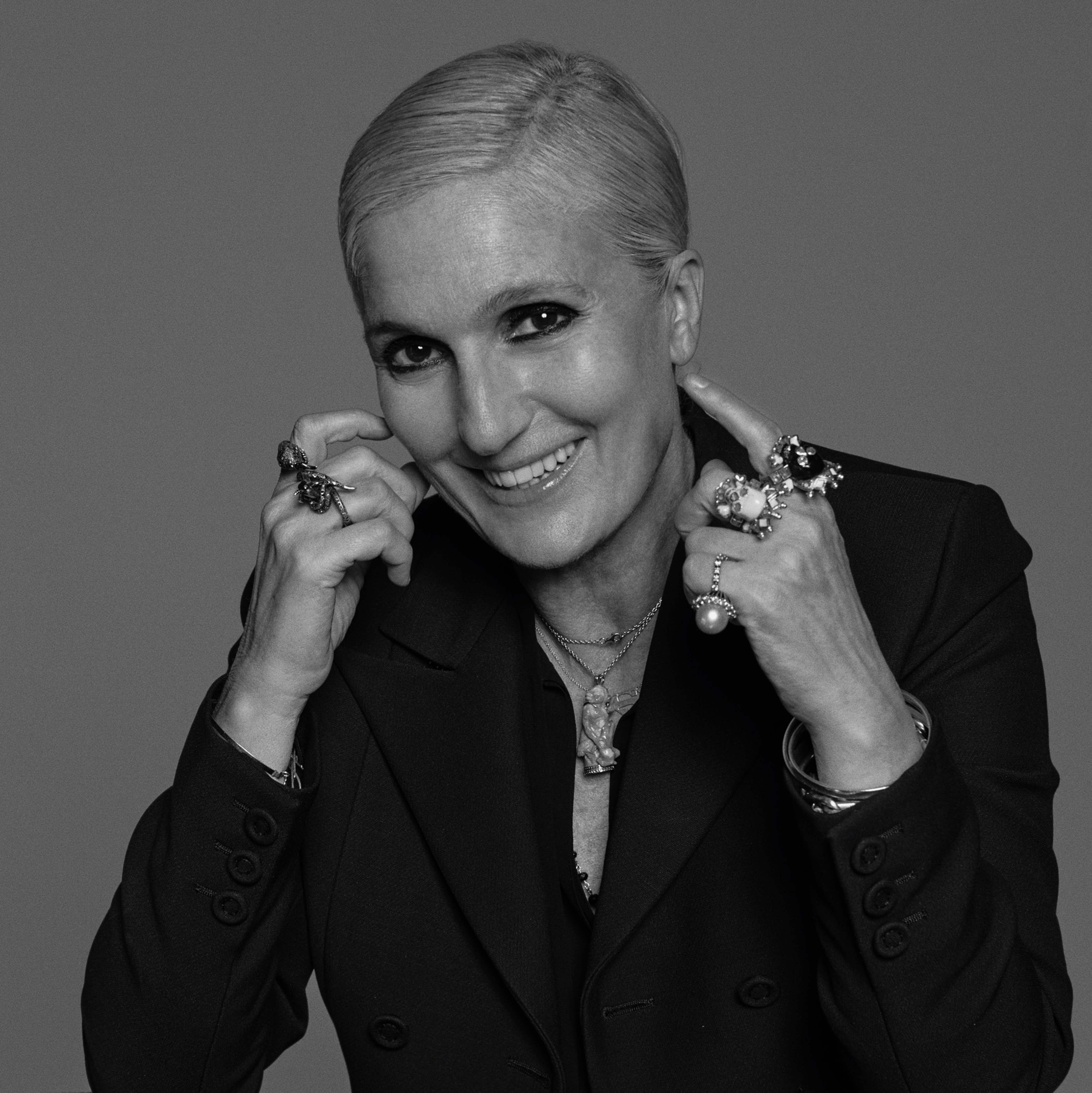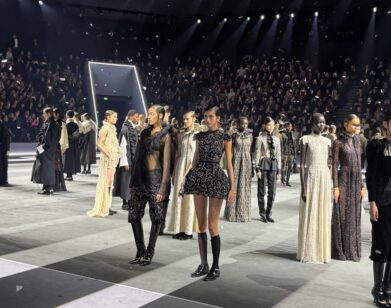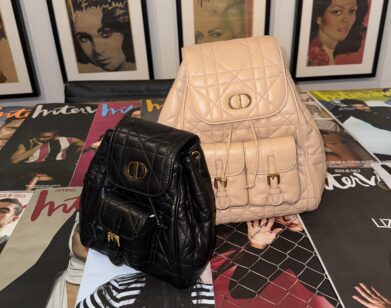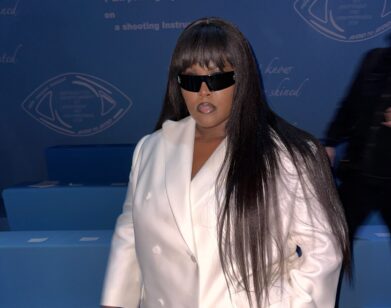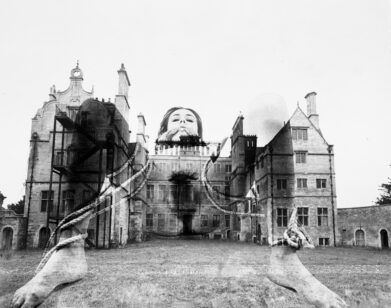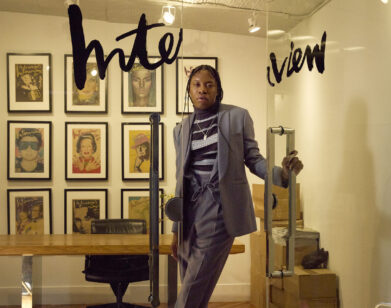Maria Grazia Chiuri talks Dior’s past and future with Bianca Jagger
When Maria Grazia Chiuri took the reins at Dior in July 2016, there was considerable speculation about what she would bring to the brand. But after she showed her first collection as the label’s creative director at Paris Fashion Week that September, the answer was clear. Chiuri’s Dior debut nodded to the house’s past—gown straps were adorned with the founder’s name in a bold sans serif font—while simultaneously propelling it into the future with T-shirts that alerted show-goers that “We Should All Be Feminists.”
The Rome native got her start at Fendi in 1989 as a designer in the accessories department alongside Pierpaolo Piccioli, the man who would become her long-term collaborator and creative partner. A decade later, the two moved over to Valentino, where they breathed new life into the company as co-creative directors. Under their leadership, sales soared and in 2015 the brand won the CFDA International Award.
Christian Dior founded his namesake fashion house in 1946. After his death, a string of talented designers filled his shoes, from Yves Saint Laurent to John Galliano to, most recently, Raf Simons. Nine months after Simons exited Dior, Chiuri was named his successor, leaving Piccioli as the sole creative director at Valentino and making Chiuri the first woman hired to oversee the iconic French label.
Chiuri’s new Spring/Summer 2018 pieces once again convey her appreciation for the arts, building on the feminist ideologies that were present in her first collection. A new top, for example, referenced Linda Nochlin’s seminal essay “Why Have There Been No Great Women Artists?” which was handed out in full to the show’s attendees. That, along with Chiuri’s dreamy resort 2018 presentation, which was held in the middle of the California desert, shows that she does not simply send clothing down a runway in a vacuum, but rather creates immersive experiences for clients who are more engaged and aware than ever before.
From London, the iconic feminist and human rights activist Bianca Jagger got on the phone with her friend Chiuri in New York to discuss the designer’s singular creative perspective and how she reconciles history and modernity.
BIANCA JAGGER: Maria Grazia, how are you?
MARIA GRAZIA CHIURI: Exhausted. [laughs] I hope the next time that we talk we can do it in real life, not by phone. It’s really strange by phone.
JAGGER: When I think of you, the first thing that comes to mind is that you are a brave woman who is willing to take risks. Tell me, what was your reaction when Dior approached you for the job?
CHIURI: I was surprised. I met Mr. Toledano [Sidney Toledano, the former president and chief executive of Christian Dior Couture] many years ago, and I was surprised I was offered the job because our first meeting wasn’t very easy. I actually said, “Oh, that’s strange that you’re calling me again.”
JAGGER: Was it he who approached you?
CHIURI: He told me that he would like to speak with me again, and I decided to be very clear with him about my point of view on the Dior house and on fashion. So I said, “I would like to join Dior, because it’s a big opportunity, but we have to be able to think about the brand in a different way.”
JAGGER: Did you talk about what you wanted to do creatively?
CHIURI: No, it was more about what it means to me to be a legacy brand today. I told him that we have to respect our past, but at the same time, we have to speak to women in a contemporary way.
JAGGER: Were you apprehensive that you would have to change where you live and that your children would have to move to a completely new world with a new language? And that you would become creative director of a fashion house that has had so many extraordinary designers at its helm before?
CHIURI: I was not scared because I’m a little bit of a crazy woman. I’m 53—I want to test myself. I might be wrong, but that’s okay. I think it’s important to take risks. Initially, it wasn’t so clear in my mind what Dior was like because it’s different when you see a brand from the outside versus from the inside. When I arrived and began to understand how huge the brand is, I said, “Oh my god…” But I found it so exciting, and I put all my passion and creativity to work for the brand.
JAGGER: How do you see yourself fitting into the legacy of Dior designers, such as Monsieur Dior, Yves Saint Laurent, Mark Bohan, Gianfranco Ferré, John Galliano, and Raf Simons?
CHIURI: Dior has been so clever to always have the best designers for each moment. Did you know that Monsieur Dior was only there for ten years? People probably don’t understand that he created a truly worldwide brand in just ten years. It expanded to Australia, America. And this was only about a year after the war.
JAGGER: He was revolutionizing fashion.
CHIURI: Yes! It was unbelievable. I am also fascinated by Saint Laurent, who was the second designer at Dior, as well as Marc Bohan, who people don’t know so well.
JAGGER: I do! He dressed me—he made beautiful things for me.
CHIURI: Oh, yeah? I really loved his work. Galliano is very close in my memory because he is a part of my generation. And of course, because I’m Italian, I remember Gianfranco Ferré well. I know Raf Simons very well, because he’s my contemporary—because we’re working at the same moment in fashion. And I don’t want to forget Hedi Slimane. Slimane at Dior Homme was very important, and he did petite taille for women. The legacy of Dior is composed of all of these designers; they’ve all added elements that people remember. For me, this is normal, probably because I was born in Rome. If you’re born in Rome, you know that history is important and that it’s part of your present. I always remind myself what is important about Dior’s past so that it can be in dialog with what I’m trying to do now.
JAGGER: How does it feel to be the house’s first female designer?
CHIURI: It feels like a big responsibility. When I started to be interested in fashion, when I started to study fashion, it was different— we used fashion to express ourselves, to enjoy it. But now everything moves so much faster in fashion, and I don’t want to impose anything on women. I want women to find themselves. I want to support women in trying to find pieces that they really like that they believe really work with their spirit.
JAGGER: Their style.
CHIURI: Yes, their style. I think it’s important to remember that we are all different, and that fashion has to support this difference.
JAGGER: So you don’t want to be a designer who tells women the length of clothes that they should wear, the color, whether it should be big shoulders or small shoulders, long skirts or short skirts?
CHIURI: I want to give my point of view, but at the same time I want women to decide what they want. Fashion is something to enjoy, not something that has to be restrictive. A woman has moments when she wants to be more elegant and others when she wants to be more rock ’n’ roll or more sensual or more masculine.
JAGGER: What does feminism mean to you?
CHIURI: Maybe because I was born into a family where I didn’t think of myself as a female. I thought of myself as Maria Grazia, a person. My father and mother taught me, “You have to study, you have to work, you have to be independent.” Later, I understood what it meant to be a woman because other people saw me that way, and I thought, “Why are they this way with me?” When I started to work, it was at a family-owned company with five unbelievable women. So it was normal for me to see women in positions of power. It was completely normal to have a family, to have kids, to work, to go around the world. It was only later that I discovered that my career was a bit unusual. I was very supported by my husband and family, but not all women have the opportunity to find balance between their personal lives and their aspirations.
JAGGER: The 2016 World Economic Forum report showed that it would take 170 years for women to close the pay gap and be paid as much as men are. In preparing my speeches about women’s rights and gender equality, that was probably one of the most striking pieces of information. So I want to talk about your T-shirt that says, “We should all be feminists.” Did you set out to make feminism mainstream in the fashion industry?
CHIURI: I did the first Dior show in one month, and I didn’t even think about it. It was … I don’t know the right word … [speaks Italian]
JAGGER: It was passion.
CHIURI: It was passion. It was a moment in my life when I was speaking a lot about feminism with my daughter, Rachele. I never imagined this reaction, honestly. I did it because I felt like it was the right message to send. I remember I got to the Dior office and asked, “Could you contact Chimamanda Ngozi Adichie please?” They looked at me strangely and asked, “Who is that? Why do you want to speak with a writer?” So I told to them, “I wrote a letter to her because I want to use the title of a book of hers for the show.” When she accepted, I was really happy.
JAGGER: You mentioned your daughter—I know that you pay great attention to what she thinks. I read that you once wanted to make a kimono and she told you not to do it. [Chiuri laughs]
CHIURI: I have two children: Rachele and my son, Nicolo. She’s 21 and he’s 24. They are the future. I listen to them so that I can have a dialogue with the new generation. When I started in fashion, there were no computers, no Instagram; now your dialogue is with people who are digital, so you have to understand them. They have a lot of information and they might look at the same thing in a different way, so something that I appreciate could be wrong to them. I try to understand why they have a different point of view, and, honestly, I believe that they teach me a lot more than I could ever teach them.
JAGGER: Tell me about Nicolo.
CHIURI: He’s an engineer. He’s a complete nerd, Bianca. [laughs] He has no interest in fashion. He dresses himself in a very basic way, but at the same time, he’s obsessed about the quality of things, if something is cotton or not cotton.
JAGGER: Do you think about the environmental impact of the fashion industry? According to reports, it is the second most polluting industry in the world.
CHIURI: I think that fashion has to honestly reflect on this issue—all the companies. We also have to think about this because the new consumer is more attentive to it.
JAGGER: Fashion is all about where the clothes are made. For example, lots of houses are producing clothes in Myanmar, where there is an ongoing genocide against the Rohingya people.
CHIURI: It’s not possible to not think about that. We are lucky that because we are a couture house, we manufacture in Paris.
JAGGER: Who are the designers, artists, and writers who have inspired you and continue to inspire you?
CHIURI: I’m completely obsessed with Brigitte Lacombe because she is an amazing photographer, but also writer and artist. I referenced [the French-American artist] Niki de Saint Phalle in my last collection; she is very inspiring to me. Art helps you to understand your time and also speaks to many issues that are very close to fashion, so I am always curious to see all the exhibitions and read as many books as possible. I am never finished learning. I have to continue to become more cultured if I want to do something good. There is no other way.
JAGGER: I see that last spring you launched The Women Behind the Lens, where you invited many female photographers to interpret Dior pieces with their own personal vision.
CHIURI: Yes, because I think that photography is an art that gives a point of view to women. I hope to continue this project in the future and work with female photographers of different nationalities because women are multifaceted, so if you want to describe women you need to see all the different aspects.
JAGGER: Where do you see the fashion industry heading? How can the house of Dior make fashion more inclusive and diverse?
CHIURI: I think that we can be more inclusive if we apply our values—such as craftsmanship and creativity— to not only expensive pieces, but also to simpler pieces, like denim pants or a T-shirt.
JAGGER: I wanted to tell you that your jackets are so well-cut. I can put them on without having to have anything tailored. Sometimes jackets can be too long-waisted or too tight, but you fit them right. I think it’s because you are a woman and you think of women’s real bodies, not just some imaginary body, like some designers.
CHIURI: I’m so happy you said that because that’s my goal.
JAGGER: Who is the ideal woman that you would like to dress?
CHIURI: I have to do my job well for all women, not an ideal woman. I appreciate when I see women who mix a dress I designed with other brands, and in the process find a look that’s completely new. That excites me because I think, “Oh, cool, I never thought of that.”
JAGGER: What do you want to accomplish now? What are your goals for the future?
CHIURI: I would like for the new generation to see Dior as a house that reflects all types of women, because Dior is a worldwide brand. I think that all people, men and women, want to be unique in some way, but at the same time, they would like to belong to a community. I would like if they could find in the Dior house a community where they can express themselves in a personal way.
JAGGER: Tell Rachele that she shouldn’t be so tough on you. She should allow you to use a kimono in your fashion show.
CHIURI: [laughs] I wear a lot of kimonos myself.
JAGGER: I love kimonos, too.
CHIURI: [laughs] I’ll have to think about this, Bianca.
BIANCA JAGGER IS A SOCIAL JUSTICE ADVOCATE AND THE FOUNDER OF THE BIANCA JAGGER HUMAN RIGHTS FOUNDATION.

